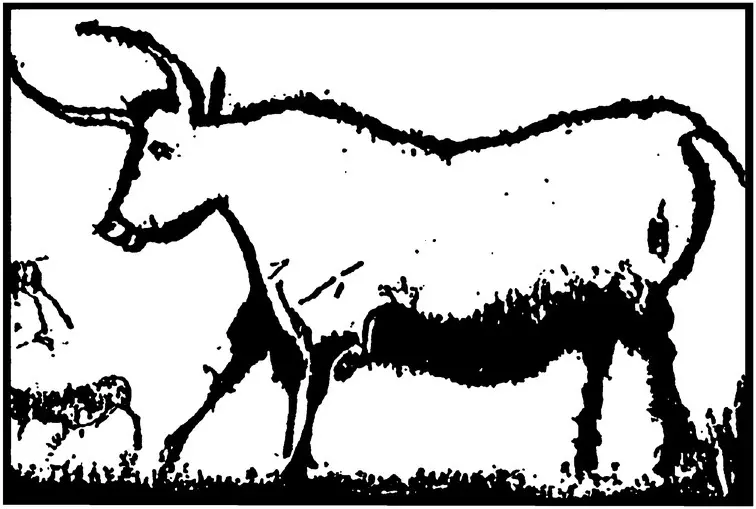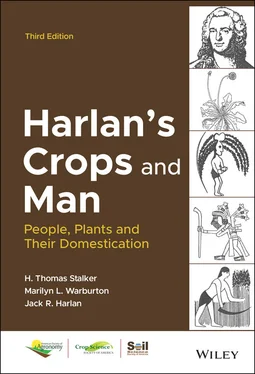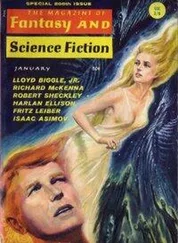Dr. Harlan formulated five concepts as related to crop plant evolution: first, the “Compilospecies” concept where related species intermate to form hybrid swarms with high levels of fitness and aggression, and which are able to expand their ecological range. Secondly, he understood the relationships between crops and companion weeds, and the importance of introgression to maintain diversity in a species. Third, Vavilov’s Centers of Origins, which were more centers of diversity than origin, were revised into larger areas. Dr. Harlan recognized that not all crops had distinct centers and that the center of origin is not necessarily (and is more often not), the center of diversity. Fourth, he understood that the origin of crop domestication occurred for different reasons by various peoples and no one concept fits all situations. Thus, he developed a no‐model model to incorporate the array of theories for crop domestication. Lastly, a natural classification of cultivated plants was proposed that consisted of gene pools rather than the classical method of morphological descriptions. This allows the thousands of variants of a crop to be lumped together into a single genetically and reproductively unified gene pool.
For his masterful accomplishments and service to the agriculture community, Dr. Harlan received many highly prestigious recognitions and awards, both nationally and internationally. His contributions have been recognized in symposia and in Europe a conference series named after him continues to bring together scientists to discuss topics in crop plant evolution.
Jack Harlan was a brilliant scientist and a true scholar. He stimulated all those who knew him to explore new avenues of learning and to never stop acquiring knowledge, not only in their specialty, but in related fields as well. Jack R. Harlan was my mentor, graduate advisor, and friend.
Harlan’s use of the word “man” to describe all people was commonplace at the time of his writing. We have left this gender non‐descript word use in our attempt to maintain the original flavor of his entertaining story style, and trust our readers understand we mean no disrespect.
In this revision, we hope that young plant scientists will broaden their views of the world around them to better understand the evolution of humans and the plants that feed the world. The book does not present the genetics of speciation, polyploidy, or plant breeding. But rather, it is intended to present views of evolution through the personal experiences of Jack Harlan and set the foundations for patterns of crop diversity.
H. Thomas StalkerRaleigh, North Carolina
1 Prologue: The Golden Age

First of all the immortals who dwell on Olympian homes brought into being the golden race of immortal men. These belonged to the time when Kronos ruled over heaven, and they lived like gods without care in their hearts, free and apart from labor and misery. Nor was the terror of old age on them, but always with youthful hands and feet they took their delight in festive pleasures apart from all evil; and they died as if going to sleep. Every good thing was theirs to enjoy: the grain‐giving earth produced her fruits spontaneously, abundantly, freely; and they in complete satisfaction lived off their fields without any cares in blessed abundance.
Hesiod, eighth century BC(Translated by R. M. Frazer, 1983)
In this book, we shall be dealing with evolution. We shall try to describe the evolution of crop plants from their wild progenitors to fully domesticated races and the emergence of agricultural economies from preagricultural ones. We shall deal with the activities of man that shaped the evolution of crops and that influenced the shaping of crops as human societies evolved. Crops are artifacts made and molded by man as much as a flint arrowhead, a stone axe head, or a clay pot. On the other hand, man has become so utterly dependent on the plants he grows for food that, in a sense, the plants have “domesticated” him . A fully domesticated plant cannot survive without the aid of man, but only a minute fraction of the human population could survive without cultivated plants. Crops and man are mutually dependent and we shall attempt to describe how this intimate symbiosis evolved.
The word “ evolution ” means an opening out, an unfolding, a realization of potential as in the opening of a flower or the germination of a seed. It implies a gradual process rather than sudden or cataclysmic events, with each living thing being derived genetically from preceding living things. Evolution as a process means change with time and the changes may be relatively slow or rapid, the time relatively long or short. Thus, the differences brought about by evolution over time may be small or great. As we shall see, some cultivated plants differ very little, if at all, from their progenitors. The same can be said for the evolution of agricultural economies and the sociological changes that have occurred in the process of developing fully agricultural and industrial societies from hunting–gathering systems.
To develop a degree of understanding of what has happened and what agricultural systems mean to mankind, we need some sort of picture of what life was like before agriculture. We need to establish a baseline from which we can visualize the domestication of plants and the emergence of agriculture. What kinds of plants did man eat before today's crops were available? What did he know about plants, and what might have caused him to begin the process of domestication? The descriptions given here will necessarily be brief and sketchy, but will give an idea of the condition of man before he began to grow plants with the purpose of using them for food.
We also need to know something about man as a hunter to understand ourselves. Lee and DeVore (1968) have put it succinctly:
Cultural Man has been on earth for some 2,000,000 years; for over 99% of this period he has lived as a hunter‐gatherer. Only in this last 10,000 years has man begun to domesticate plants and animals, to use metals and to harness energy sources other than the human body.… Of the estimated 80,000,000,000 men who have ever lived out a life span on earth, over 90% have lived as hunters and gatherers; about 6% have lived by agriculture and the remaining few percent have lived in industrial societies. To date, the hunting way of life has been the most successful and persistent adaptation man has ever achieved.
As a matter of general education and self‐understanding, it is important that we know something about this basic human adaptation. There are two general approaches to the problem: (a) we can study surviving nonagricultural societies and examine the ethnographic observations made within the last few centuries, or (b) we can attempt to interpret preagricultural life from the artifacts, refuse, and other clues left by ancient man and recovered by archaeological techniques. In this chapter, we shall deal primarily with the first approach but the archaeological record shall be touched on in later sections.
The Hunter‐Gatherer Stereotype
Traditionally, agricultural people have looked down on hunting people who are described as “savage,” “backward,” “primitive,” “ignorant,” “indolent,” “lazy,” “wild,” and “lacking in intelligence.” Europeans applied the term “civilized tribes” to some eastern North American natives who lived in towns and cultivated plants, but these Native Americans themselves referred to the hunting tribes of the plains as “wild Indians.” In Africa, farming groups that surround hunter‐gatherers, “… did not merely assert their political dominance over the hunter‐gatherers and ex‐hunter‐gatherers they encapsulated; they also treated them as inferiors, as people apart, stigmatized them and discriminated against them” (Woodburn, 1988, p. 37). Similar attitudes prevail in Asia, Oceania, and Tropical America. The prejudice is nearly universal.
Читать дальше













